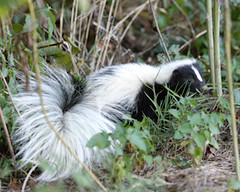 A few years back, the Washington Post asked why skunks flunk Arlington. The County's new natural heritage resource report (PDF) takes an in-depth look at a long list of species & their relationships with Arlington, concluding Arlington just isn't good skunk habitat:
A few years back, the Washington Post asked why skunks flunk Arlington. The County's new natural heritage resource report (PDF) takes an in-depth look at a long list of species & their relationships with Arlington, concluding Arlington just isn't good skunk habitat:Striped Skunk Mephitis mephitis nigra. The striped skunk is well known, but rarely encountered in Arlington. Historical records include a single early record from 1878 (Four Mile Run) and a later record in 1946 from N. Nelson St. The absence of skunks from the local environment is not unexpected. Based on dietary need, skunks primarily inhabit open fields, old field meadows, thick brush land, pastures and farmland. Past environmental changes in Arlington have eliminated natural meadows and farmland and replaced them largely with an urban landscape or mature forest. Over the course of the wildlife inventory, a number of citizen reports were received claiming to have smelled an odor of skunk. A number of these reports were later dismissed as unverifiable or mistaken as male red fox scent. However, two reported observations within the period of 2003-2006 were followed up by interviews. In both cases, the reports were deemed credible. No contemporary documentation exists in the form of photos, bones, fur or scat. In addition, no road kills have been reported within the last ten years by two different reporting agencies. Arlington National Cemetery may provide the best remaining habitat for skunks in Arlington. Striped skunks remain more common in the less developed portions of Fairfax and Prince William Counties. Current Status: Rare, does not occur every year.One other interesting note from the report - get ready for more deer in South Arlington.

No comments:
Post a Comment